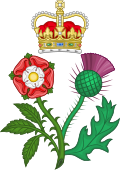Coat of arms of Great Britain
Appearance
(Redirected from Royal coat of arms of Great Britain)
The coat of arms of Great Britain was the coat of arms used by the monarchs of the Kingdom of Great Britain, which existed from 1707 to 1801. The kingdom came into being on 1 May 1707, with the political union of the Kingdom of Scotland and the Kingdom of England, which included Wales. The Kingdom of Ireland remained separate, but was represented in the Royal Arms by the harp of Ireland.
On 1 January 1801, the coat of arms was superseded by the coat of arms of the United Kingdom of Great Britain and Ireland, a new kingdom created by the Acts of Union of 1800, which united the kingdoms of Great Britain and Ireland.
Coats of arms
[edit]| Arms | Dates | Details |
|---|---|---|
| 1707–1714 | When the Acts of Union 1707 created the Kingdom of Great Britain (1707–1800), the Royal Arms of England and Scotland were impaled and moved to the first and fourth quarters, with the royal arms of France in the second quarter and the harp of Ireland in the third.[1] | |
| 1714–1800 | Following the death of Queen Anne, George I, previously Elector of Hanover inherited the throne under the provisions of the Act of Settlement 1701, and as a result the fourth quarter of the arms was changed to represent the new king's titles in Hanover: this quarter marshals Brunswick, Lüneburg and Westphalia, surmounted by the Imperial Crown of the Holy Roman Empire for the Holy Roman office of Archtreasurer.[1] |
Notes
[edit]- ^ a b Brooke-Little, J. P. (1978) [1950]. Boutell's Heraldry (Revised ed.). London: Frederick Warne LTD. pp. 205–222. ISBN 0-7232-2096-4.
Categories:
- National symbols of Great Britain
- Royal arms of European monarchs
- British coats of arms
- National coats of arms
- Coats of arms with unicorns
- Coats of arms with chains
- Coats of arms with lions
- Coats of arms with crowns
- Coats of arms with fleurs de lis
- Coats of arms with harps
- Coats of arms with horses
- Coats of arms with roses
- Coats of arms with shamrocks
- Coats of arms with thistles
- Coats of arms with crosses







